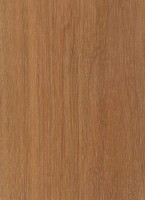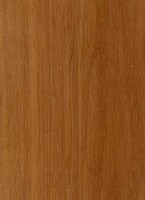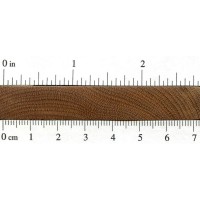 |
Common Name(s): Hophornbeam, American Ironwood Scientific Name: Ostrya virginiana Distribution: Eastern North America Tree Size: 40-60 ft (12-18 m) tall, 1-2 ft (.3-.6 m) trunk diameter Average Dried Weight: 49 lbs/ft3 (785 kg/m3) Specific Gravity (Basic, 12% MC): .63, .79 Janka Hardness: 1,860 lbf (8,270 N) Modulus of Rupture: 14,100 lbf/in2 (97.2 MPa) Elastic Modulus: 1,700,000 lbf/in2 (11.72 GPa) Crushing Strength: 7,760 lbf/in2 (53.5 MPa) Shrinkage: Radial: 8.2%, Tangential: 9.6%, Volumetric: 18.6%, T/R Ratio: 1.2 |
Color/Appearance: Wide sapwood is white to pale yellow. Heartwood is a light brown, sometimes with a reddish hue. Overall appearance can be very similar to birch.
Grain/Texture: Grain is usually straight, with a medium, uniform texture.
Endgrain: Diffuse-porous; small to medium pores commonly in a diagonal or dendritic pattern, moderately numerous to numerous; solitary and radial multiples of 2-3; growth rings usually distinct; narrow rays not visible without lens, fairly close spacing; parenchyma banded (faintly visible).
Rot Resistance: Heartwood is rated as non-durable to perishable regarding decay resistance, and is also susceptible to insect attack.
Workability: Overall, a difficult wood to work. Hophornbeam has high cutting resistance, (which also means that the finished wood product has good wear resistance). Reacts poorly to steam bending attempts. Turns, glues, and finishes well.
Odor: No characteristic odor.
Allergies/Toxicity: Hophornbeam has been reported to cause skin irritation. See the articles Wood Allergies and Toxicity and Wood Dust Safety for more information.
Pricing/Availability: Because of its small size, Hophornbeam is seldom harvested commercially. Likely to be limited in availability, even within its natural range. Expect prices to be high for a domestic hardwood.
Sustainability: This wood species is not listed in the CITES Appendices or on the IUCN Red List of Threatened Species.
Common Uses: Furniture, canes, tool handles, and other turned objects.
Comments: Hophornbeam is a member of the Betulaceae family, and is somewhat related to Birch (Betula genus) and Hornbeam (Carpinus genus). So named because the fruit bears a resemblance to the fruit on hop vines, hence “hop-hornbeam.” Sometimes referred to as “Ironwood,” though it is one of the few hardwoods bearing this name that do not actually sink in water. The name is instead given for the wood’s toughness and resistance to wear and abrasion.
None available.
None available.








If u are lucky enough to find one on your property, rip one into long pieces and make nice longbows out of them….better than hickory for bowmaking…or dry/sell them as bow blanks on craigslist! Worth money!
Great to hear. I just bought a property with a tree 50′ tall about 20″ in diameter, in good health, having two straight spires